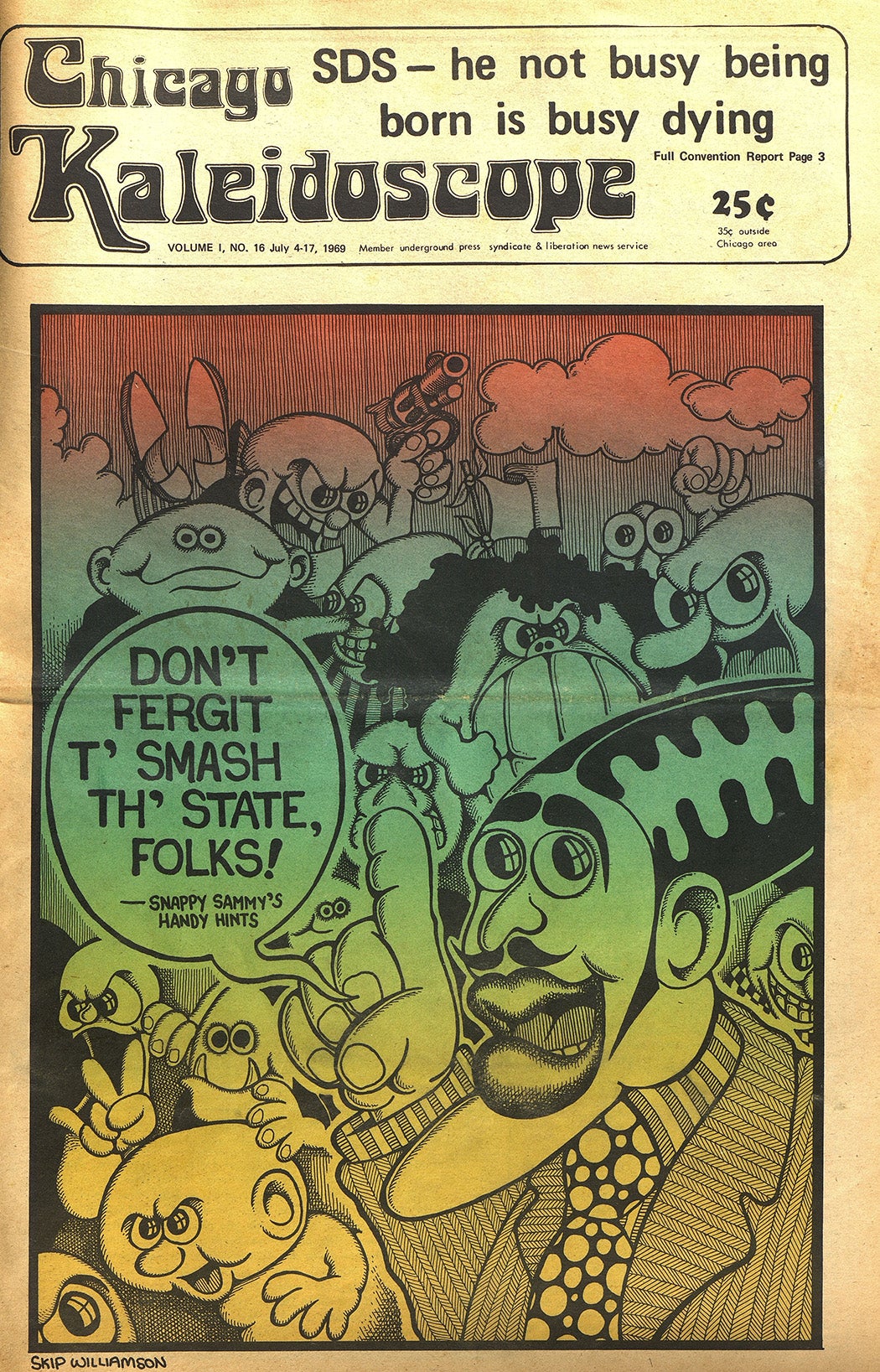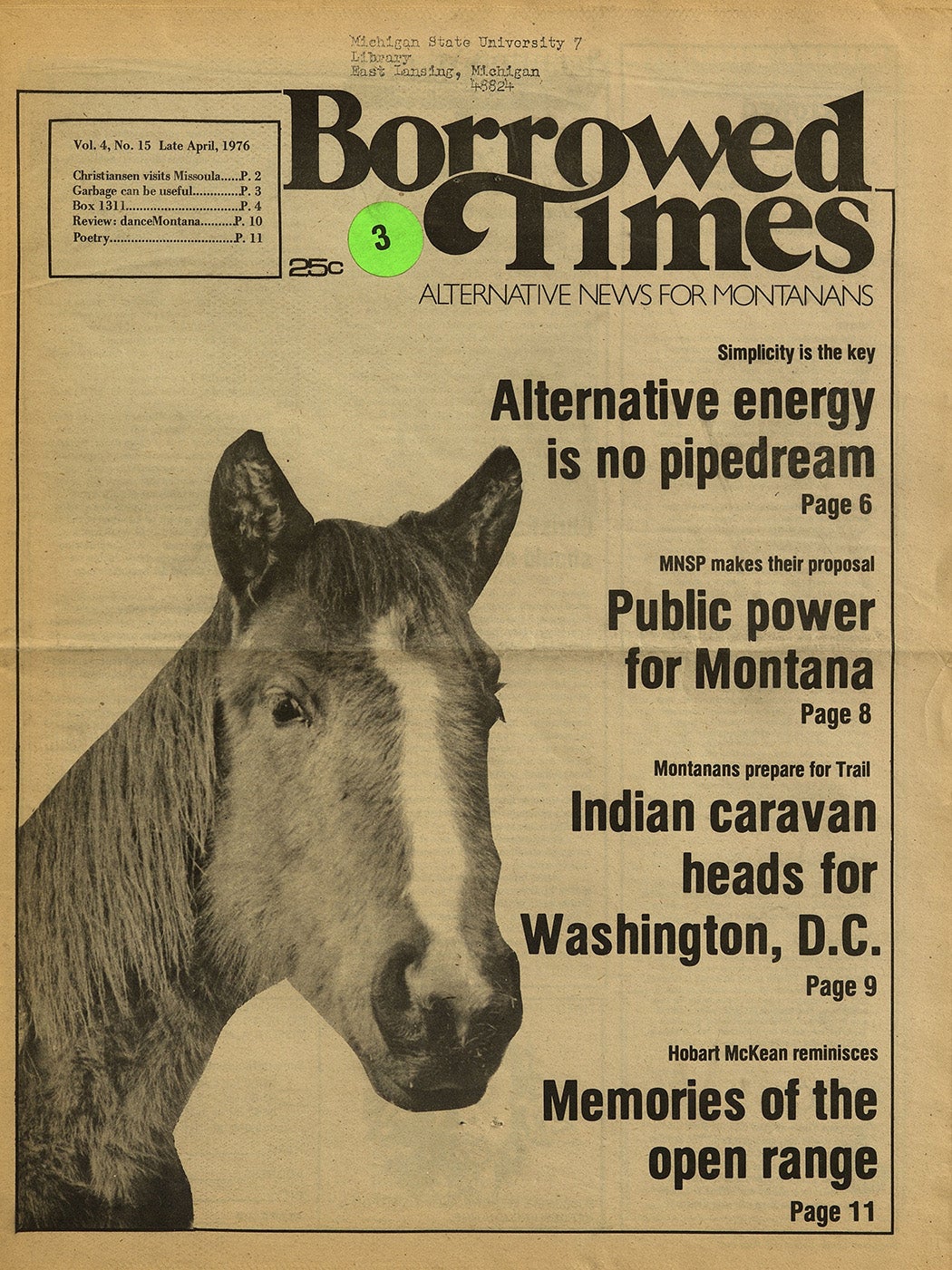Famous for its social movements—against the Vietnam War, in defense of the planet, demanding Black civil rights, gay liberation, and women’s equality—the 1960s and 1970s were also a fertile time for the underground press in the United States. Reveal Digital’s Campus Underground collection on JSTOR includes more than seventy-five publications, many from college campuses or college towns (often produced by a loose cluster of students and other college-aged young people). The open access digital archive provides an exhilarating glimpse into this creative and politically incendiary period.
The explosion of small publications alongside the political upheaval—the latter of which is documented in a companion collection, Student Activism—is not a coincidence. Historically, an alternative press has thrived when social movements are most active. Political organizing gives the alternative press more material to write about. The movements also produce more readers for such outlets: in politically charged times, more people are open to new ideas and question established news sources.
Weekly Digest
In the nineteenth century, for example, newspapers like William Lloyd Garrison’s The Liberator, calling for the abolition of slavery, thrived along with the abolitionist movement. By contrast—despite the pervasive racist violence suffered by Black Americans after the Reconstruction—there were few organized mass movements demanding the human rights of Black Americans until the 1930s. As a result, crusading journalist Ida B. Wells, most famous for chronicling the horror of lynching, was a lone voice writing and publishing on the subject, often tragically unheeded and even ostracized in her time.
In the mid-twentieth century, the idea of a “mainstream media,” one that reflected an elite consensus and protected the status quo, emerged with the Nixon Administration’s campaign against media, and the analysis was embraced by many on both the right and the left. Richard Nixon wouldn’t have agreed with the hippies on many issues, but he concurred with their hatred of the elite media. The idea of a mainstream press concealing important knowledge from the public produced a demand for alternatives. The mission of the underground press, then, was to provide these independent sources of news, or, as The Berkeley Barb put it in 1967, “what the dailies didn’t tell.”

The underground press argued that the “dailies,” or daily newspapers, didn’t look critically at powerful institutions and people, and that it was the job of the independent press to do so. The police (“pigs,” in the blunt parlance of the time) attract special scrutiny. Kaleidoscope Chicago, in its July 4, 1969 issue, covered a police riot in Ann Arbor in a story headlined “Pig fever in Ann Arbor,” correcting the mainstream media’s version of the same event. The underground paper reported that the “establishment press and TV” called the police violence “worse than any in the 1967 Detroit riot.” Yet, Kaleidoscope observed, “the main difference in this case seems be that the pigs were beating white people.” The underground paper noted that by some accounts as many as 200 Black people had been killed in the Detroit riots.
Police weren’t the only “pigs” deemed worthy of scrutiny; on the cover of a 1974 issue of The Seed, another Chicago-based paper, three oil companies, Shell, Standard Oil, and Texaco are depicted as pink storybook-style barnyard animals, dancing with glee in front of a refinery pouring oil into a troublingly orange, darkening atmosphere.
The underground press also assumed the mainstream media wouldn’t cover social movements and devoted themselves to doing so. As a result, their own papers are probably some of the best sources on the political protests of this period. The creators of The Borrowed Times, based in Missoula, Montana, and launched in 1972, were inspired to start their underground paper when their local antiwar demonstrations were covered “poorly and unfairly” by the Missoulian, the local daily.
The Borrowed Times, which lasted until 1980, extensively covered labor, feminist, and environmental struggles in the area. A 1977 cover story chronicled a housekeepers’ strike for a living wage at the local Red Lion, and in 1976, the paper prominently featured local demands for public power and alternative energy (“Alternative Energy is no Pipedream”). Several different newspapers associated with Students for a Democratic Society (SDS), the organization associated with the famous Port Huron Statement, documented the group’s antiwar and antiracist activities. The Berkeley Barb, which boasted some famous “creators” on its masthead, like Paul Krassner and Tuli Kupferberg, provided copious coverage of Bay Area left activism, from Black Panthers making common cause with peaceniks to division and red-baiting in Berkeley City Council races.

The writers, editors, and artists of the underground press viewed their own work as a form of activism. Sometimes the establishment agreed and repressed it fiercely. The Kudzu, a Jackson, Mississippi, paper founded by students and young people across the state, became a news story itself in October 1968, when several of its staff members were beaten, arrested, and jailed for selling the paper to high school students. A judge found them guilty of intending to “brainwash the infantile minds” of the high school kids. “In other words,” explained The Kudzu in its report on the incident and trial, “they were on trial for their political beliefs, for the contents of their publication.”
The Berkeley Barb writers made a different kind of trouble, going on strike when the owner (referred to in their report on the matter as “Capitalist pig Max Scherr”), who was “spiritually” advised by Timothy Leary, refused to accede to their demands, which ranged from fair wages to redistribution of his profits to the community. The writers then published one issue of “Barb on Strike”, a new and discrete publication formed to explain the controversy to the public.
The underground press’s critique of the mainstream media was not limited to its failures in political coverage. It was also, along with the rest of mainstream culture, indicted by the hippies for stultifying conformity, puritanical mores, and lack of creativity. The underground press provided a forum, then, for the counterculture as well as for political radicalism, often seeing the two as inextricably intertwined.
A literary and arts magazine in this vein called Zeitgeist emerged from Michigan State University and its surrounding East Lansing community and published from September 1965 to January 1969, succeeded by a short-lived descendant called Poltergeist in October 1968. Zeitgeist declared in its founding issue that it was inspired by “frustration” with the lack of outlets for “critical and creative talent.” Existing local media, the editors lamented, echoing midcentury rebels throughout the land, were “hampered by a tradition of mediocrity and dominated by a desire to remain uncontroversial.”
In many of the papers, hallucinogenic visuals provide a diverting antidote to the numerous Angry Nixon cartoons. On the April 1973 cover of The Seed, a woman’s flowing hair turns into a peacock, against a background the shade of blue associated with a Renaissance Virgin Mary’s headdress.

Change was not going to come from protest or politics alone, many underground press creators believed. An early issue of The Seed, whose editorial team included the famous advocate of “unschooling” John Holt (who died in 1985 but remains influential among homeschoolers and radical educators), asserted in September 1967: “All governments will be the same until people change.” The guest editorial continued,
We are convinced that if men can find enough joy in life, all of them, that none will tyrannize over another….
We are not stripped merely to wear a new uniform; we do not learn that the schools and newspapers have lied, merely to substitute more propaganda. We must be the new man, the naked, sexual man, the compassionate man. ‘The impossible possible philosopher’s man, the man who has had time to think enough’…And if he does not exist we must each invent him. This is a warning and a plea.
The archive provides a glimpse of a world where pleasure is often inseparable from protest. Before the kids in Kaleidoscope’s report got beaten up and tear-gassed, they were “Doing It in the Road.” Yipster Times, which published throughout most of the 1970s, offers a spirited chronicle of such intersections. The June 1973 cover—which features a cartoon of a Nixon with a noose around his neck and the headline “Nixon Goes to Pot”—flagged a special issue dedicated to a nationwide effort to “smoke out” Nixon, by gathering in public and smoking marijuana.
In the decades following this heyday of the underground press, the remaining independent media, with no social movements to sustain them, would decline into haranguing severity, humorless moralizing, and austere aesthetics. Left-wing columnist Alexander Cockburn once quipped in the late eighties, sorting his mail and noting the dreariness of such well-meaning headlines as “STOP THE KILLINGS”—whose unintentional dark comedy was their timelessness, their applicability to everything—”Oh, come now, can’t we have some killings of our own?”

Back then, this “Campus Underground” archive would have seemed purely nostalgic, a fleeting remnant of a radical energy that might never come back. But in our own time, the exuberance of the underground media era feels more recognizable than it would have in the Reagan/Bush era. People are protesting in the streets again, decrying racism, criticizing corporate abuses, rejecting the capitalist system. Today, countless left-wing podcasts, journals and YouTube channels—not to mention Twitter itself—provide an alternative to the mainstream media, as well as a counter to far-right misinformation and conspiracy theories. Perhaps this archive will provide some inspiration—and amusement—to our contemporary media-makers.
Editor’s note: This piece was updated to clarify the singularity of Ida B. Wells’ work.







